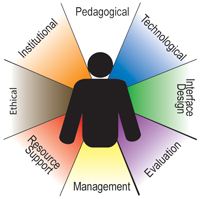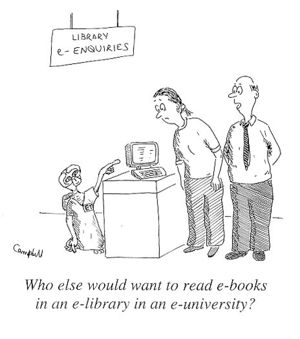E-learning Versus Classroom Learning
Contents
Introduction
Classroom learning is not a new practise. Even before the traditional school setting was created, many children were educated in large groups from a family member or friend. Although this form of education is widely understood and used, there is another form of education that has come into practise within the last century and has started to recieve great recognition; this is "e-learning". E-learning offers many new challenges, but also many great opportunites. Here, e-learning and classroom learning will be compared as a means to seek the greatest form of education present today.
e-Learning
How It Works
E-learning is a relatively new form of educating students through the use of computers as an instructional medium. E-learning is used to educate people of all different ages. It has been around for about twenty years and is used for students in primary school, secondary school, and even university level courses. Some companies actually have their employees take courses over the computer as a means to teach them more about their field or educate them on new programs they will be introducing. Often, when parents choose to put their children through e-learning for their education, parents help with a significant amount of the teaching. Once you have reached a higher level, the students are expected to be able, in some ways, to teach themselves from the materials they are given. Often these materials include multi-media online activities, print materials, web, e-mail, Internet, CD-Rom, computer software, audio/video conferencing, audio/video tapes and TV or radio. Testing is done over the computer with multiple-choice or essay structure questions, or through a scheduled examination period in a classroom setting.
History
E-Learning or electronic learning is a method of learning using the internet, computer networking or computer enhanced learning. E-Learning started in the mid 1980’s when education institutions started integrating components of e-learning into their curriculum. For example, Pearson Education, a highly reputable company has been providing “SuccessMaker”, a curriculum program to a K-12 school in Albany, New York since the 1980s. SuccessMaker is a package that provides supplemental instruction in English, Language Arts, Math, Science, and Social Studies. The students, accompanied by their teacher, will go into the computer lab multiple times a week and engage in different subjects. The school attributes their success to this program, which allows students to learn at their own pace or revisit concepts that students find difficult. The teacher can also be engaged with this program as they can download progress reports and personalized worksheets for use in their own classroom.
The 90s was an era that facilitated growth as it paralleled the growth of the Internet. In the mid 90s, “WebWork”, an e-learning tool was developed for use in mathematical instruction at the University of Rochester. Web-based Universities also began to emerge in the late 90s as Universities such as Jones International University offered select courses and degrees that could be completed through the internet. Systems such as “WebWork” also set the precedence for programs such as Desire2Learn, Blackboard and WebCT – a subsidiary of Blackboard. Desire2Learn was founded in 1999 and provides a virtual learning environment course management. Blackboard took off shortly after in 2000, and is used in many institutions as course management and is a key tool for instructors.
The use of e-learning is becoming more apparent as university and education are becoming more accessible to students in rural areas. Attending accredited post-secondary institutions no longer requires the learner to move to an urban centre, but students can travel and experience the sights of locations all around the world. As we move further into the Information Age, e-learning is becoming more prevalent and programs are being developed to streamline and enhance the learning experience.
Who Uses It
Often students choose to use this method because they can work at their own pace, they can take as many or as few classes as they wish, and they can study when they have the time. Support is usually provided from the teachers or professors that mark the student’s course work, and they can be contacted in person, over the phone, or through e-mail. Most schools have installed WebCT, Blackboard, and Desire2Learn, to help with the materials needed for e-learning; these sites can include areas to take and submit test and quizzes, courses notes, and projects and assignments. For University/College based classes, it is found that students over the age of twenty-two are more likely to take classes through correspondence, and therefore be involved in e-learning. This is probably because younger students that have just finished secondary school are more likely to like a classroom based structure, and older students like the flexibility of still being able to have a full time job or choose to study when it is convenient.
Advantages
Sharing of ideas
Online learning enables each student to view another student's answers and learn through the exposure to different perspectives through tools like Blackboard's Discussion Board and Chat. This benefits students because they can combine new opinions with their own, and develop a solid foundation for learning. Research supports that "as learners become aware of the variations in interpretation and construction of meaning among a range of people [they] construct an individual meaning."
Instructors accessibility
Online learning benefits students by providing additional layer of instructor accessibility. Students in courses that are supplemented by products like Blackboard no longer have to worry if they cannot make an instructor's regular office hours, as they still have the ability to submit inquiries via e-mail at any time. This is good for the instructor too, as they can respond at his/her convenience instead of being tied to a desk or office. This is particularly helpful when a student’s schedule conflicts with office hours or if a question arises at the spur of the moment.
Enabling student-centered teaching approaches
Every student has a unique learning style. Some are visual learners while others learn better when they "learn by doing." Online learning environments permit the instructor to build one course, yet implement a variety of resources, so students can utilize materials in whichever way works best for them.
Providing 24/7 accessibility to course materials
Some students work best in the morning, some in the evening. Some students commute to campus and others take night classes. Scheduling time for homework and group projects can be difficult depending on each student's course, job, and personal responsibilities. When course content and activities are provided online, students no longer need to worry about accessing course materials. Students can complete assignments during their most productive times.
Adds pedagogical benefits
Online learning features also have pedagogical benefits. From the student viewpoint, frequent assessment provides concept reinforcement and increases motivation. Instructors can post practice exams and end-of-chapter reviews without worrying about finding the time and resources to analyze results. Students can access these assessments at any time, privately and in the comfort of their own home. Since grading is computerized, students receive immediate feedback. This may also help students who suffer from test anxiety; allowing students to relax and minimize embarrassment for those that do poorly.
Helpful for instructors
Online Learning also helps instructors save time as they can use several useful features. For example, when the Quiz/Survey generator is used to deliver tests, all the grading and analysis is automated. Time previously spent correcting, formulating statistical deviations, and analyzing specific questions can be used for other things. Even student records can be exported directly into spreadsheets for turnover to the registrar.
Disadvantages
Costly to Produce
E-learning costs more to develop due to the advanced technology needed to run it, especially if visually rich content is used.
New Skills Needed
It requires the learner to obtain new skills to achieve success; however, some users may find technology not only to be intimidating and overwhelming, but also confusing or frustrating. This problem is evident in older users such as Generation X more than it is in Generation Y, younger consumers. Although some learners may prefer e-learning to classroom learning, they may find the resources they need to be out of reach.Affordability
Not everyone is able to afford the technology needed (computer, software, and hardware) to make e-learning work.
Minimal Social Interaction
The main problem associated with e-learning is the lack of social integration. In classroom setting there is formal and informal face-to-face interaction as well as cultural interactions. Without this, users may become more secluded in society. Finally, the learner must take on a greater responsibility and self-discipline to keep up with the learning schedule.
Classroom Learning
How It Works
Classroom Learning requires a number of students to be both active listeners and participants in the learning environment. A teacher is present; the role of the teacher is to educate the students on various subjects and life skills. In primary schools, one teacher is often present for the duration of the day. Once a student rises to higher levels such as secondary school and post-secondary school, teachers specialize in one subject and students experience different teachers for each course they take. Classroom learning allows for many different types of learning, such as, lectures, debates, labs, tutorials, and question/response discussions.
Who Uses It
Classroom learning is for all those that wish to be active participators and learn life experiences such as group work and learning. Unless parents choose electronic or home based schooling, primary to secondary schooling is all set in traditional classroom learning that involves teachers and various classmates. Post-secondary institutions also offer a variety of classes that can be taken in the traditional classroom setting, however, these often involve lectures, some tutorials, and certain classes require labs.
Advantages
Exchange of Ideas
Classroom learning provides interactive classroom setting that promotes the open exchange of ideas. Having numerous students learning in the same classroom has the added benefit of allowing students to exchange ideas and questions with one another providing another valuable learning medium that online environments cannot replicate. First-hand interaction with the educating professor also allows for ideas to be exchanged freely and without any communication barriers.
Development of Skills
In a classroom, the student not only develops his or her technical skills but can also develop presentation skills. There is interaction with people with different mind sets and a student can gain versatility.
Student-Teacher Interaction
In a class room, students can instantly clear their doubt with the teacher. The teacher can continually observe students for clues about their level of comprehension, probe their understanding, and respond to difficulties with a wide range of strategies. The teacher can engage the students in an endless variety of individualized and cooperative learning activities. The teacher can attend to student motivation and work to maintain or deepen interest and enthusiasm. Through his or her physical presence, the teacher can instil confidence and spark insight. Finally, by the instructor sharing his/her experiences, students can build upon their own knowledge and skills.
Socialization
Classroom learning promotes two levels of socialization among students via group discussions, team projects, and peer evaluation and between students and professionals via guest lectures, field trips, etc. Traditional classroom teaching provides students with the opportunity to have real social interaction with one another. This interaction in turn allows for the students to help one another in terms of academics or in terms of personal issues.
Disadvantages
Classroom Sizes
Since class sizes are usually fairly large and there is only one instructor, passive learning may take place. When shy students feel a lack of confidence, they often do not respond to questions they may have the answer to. The more vocal students might dominate the mass of classroom discussion, also forcing shy students to have problems grasping higher order learning skills and critical thinking.
Student-Teacher Ratio
Because there is only one instructor, it is difficult for them to isolate each child’s potential learning deficiency and, in turn, provide close attention to fixing the problem.
Accessibility
Schools and other forms of educational buildings are only found in certain areas and open during certain times. For some, this may be an inconvenience.
Conclusion
E-learning has been around for longer than most would realize, though it has just recently become a more popular competitor with traditional classroom learning. Although there are many advantages and disadvantages for both e-learning and classroom learning, the main deciding factor for the use of either is each individual’s personal learning style. For some, a flexible schedule, ability to work through problems on their own, and personal motivation seems desirable. E-learning would definitely be suitable for this particular individual. However, if someone prefers working in groups and interacting with other people on a regular basis, classroom learning might have a stronger appeal. Overall, the finishing product is a higher education and a more confident self.
Bibliography
Nichols, M. (2008). E-Learning in context. Retrieved March 29, 2009, from E-Primer Series. http://akoaotearoa.ac.nz/sites/default/files/ng/group-661/n877-1---e-learning-in-context.pdf
Athabasca University. (2009). Distance Education at AU. Retrieved March 29, 2009, from Athabasca University. http://www2.athabascau.ca/aboutau/distanceeducation.php
Rosenburg, Marc J. (2000). E-Learning: Building Successful Online Learning in Your Organization.Toronto: McGraw-Hill Companies. Paulson, Donald R. and Jennifer L. Faust. (2008). Active Learning for the College Classroom. Retrieved April 5, 2009, from California State University. http://www.calstatela.edu/dept/chem/chem2/Active/#authors
Stennes, Barbara Advantages And Disadvantages Of Web-based Learning., Retrieved April 2, 2009, from http://www.selfgrowth.com/articles/Advantages_and_Disadvantages_of_Web-based_Learning.html
Dwyer, Dan, Barbieri, Kathy, Doerr, Helen. Creating a Virtual Classroom for Interactive Education on the Web. The Third International World Wide Web Conference. 1995. http://www.igd.fhg.de/www/www95/.
Kubala, Tom. Addressing Student Needs: Teaching and Learning on the Internet. THE Online Journal. March 1998. http://www.thejournal.com.
Heckman, Brian E., & Owens, Dwight (1996). The Traditional Classroom, Computer-based Learning, and the World Wide Web. Retrieved April 2, 2009, from http://www.comet.ucar.edu/presentations/ams96/index.htm
Liew , Roland (2005). Live and in Person. Retrieved April 2nd, 2009, from http://www.computeruser.com/articles/2407,5,88,1,0701,05.html
Cantoni, V., Cellario, M., & Porta, M. (2003). Perspectives and Challenges in E-learning: Towards Natural Interaction Paradigms. Journal of Visual Languages & Computing. 15(5), 333-345. Retrieved March 28, 2009, from Google Scholar database
Kruse, K. (2002), The Benefits and Drawbacks of E-Learning. Retrieved on March 28, 2009, from http://e-learningguru.com
Zhang, D., Zhao, J., Zhou, L., & Nunamaker, J. (2004). Can E-Leaning Replace Classroom Learning?. Vol. 47, No.5, P75-79
Technical and Vacational School Guide (2006). Online VS Classroom Education. Retrieved on April 2, 2009, from http://www.technical-vocational-schools.com/online_classroom_learning.aspx
Nicholson, N., Nelms, J., Mariano, C., Abbott, K.J. (2006). Virtual Schools: An Ethical Option. Academic Leadership: an online journal 4(3). Retrieved April 06, 2009 from http://www.academicleadership.org/student_research/Virtual_Schools_An_Ethical_Option.shtml
History of E-Learning. (2007). Higher Education Online. Retrieved April 06, 2009 from http://www.high ereducationonlinereport.com/historyofelearning.html
SuccessMaker Enterprise. (2009). Pearson Education. Retrieved April 06, 2009 from http://www.pearsonschool.com/index.cfm?locator=PSZ152&pageitemid=1&PMDbProgramId=32505&PMDbSiteId=2781&PMDbSolutionId=6724&PMDbSubSolutionId=6731&PMDbCategoryId=1662&level=4&CFID=22629&CFTOKEN=65465564
South Colonie Central School District. (2009). Pearson Education. Retrieved April 06, 2009 from http://www.pearsondigital.com/successes/successmaker/southcolonie.cfm
About Us (2009) Desire 2 Learn: Innovative Learning Technology. Retrieved April 06, 2009 from http://www.desire2learn.com/about/
A Framework for E-learning. (n.d.). Retrieved April 4, 2009, from http://asianvu.com/bookstoread/ framework/
Studying Computer. (n.d). Retrieved April 4, 2009, from http://www.xueyuanlu.com/lesson1/Tips_files/ StudyingComputer.jpg
SealundeLearning. (n.d.). Retrieved April 4, 2009, from http://www.sealund.com/ eLearning.php
Community Learning. (n.d). Retrieved April 4, 2009, from http://www.community-learning.org.uk/webs/40/images/ Cartoon4.jpg
Ariadne. (n.d). Retrieved April 4, 2009, from http://www.ariadne.ac.uk/issue28/cartoon/ et-e-book.jpg
Nknox. (n.d.). Retrieved April 4, 2009, from http://www.nknox.k12.in.us/west/deweese/firestation/ fieldtrip.gif
Metro Kids. (n.d.). Retrieved April 4, 2009, from http://www.metrokids.com/august07/ teenworker.jpg
Kenzie Menzie. (n.d). Retrieved April 4, 2009, from http://www.kevinmenzie.com/illustrations/ graphics/nerd.jpg
Picture Book. (n.d). Retrieved April 12, 2009, from http://picture-book.com/ node/1189






